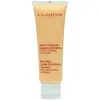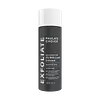Clarins One-Step Gentle Exfoliating Cleanser with Orange Extract Versus Paula's Choice Skin Perfecting 2% BHA Liquid Exfoliant
What's inside
What's inside
 Key Ingredients
Key Ingredients

 Benefits
Benefits

 Concerns
Concerns

 Ingredients Side-by-side
Ingredients Side-by-side

Water
Skin ConditioningSodium Laureth Sulfate
CleansingCetearyl Alcohol
EmollientCellulose
AbsorbentCocamidopropyl Betaine
CleansingLauramide Mipa
Glycol Distearate
EmollientCetearyl Glucoside
EmulsifyingGlycerin
HumectantAcrylates/C10-30 Alkyl Acrylate Crosspolymer
Emulsion StabilisingTea-Cocoyl Glutamate
CleansingCitrus Aurantium Dulcis Fruit Water
MaskingSilica
AbrasivePersea Gratissima Fruit Butter
EmollientParfum
MaskingPhenoxyisopropanol
PreservativeSodium Chloride
MaskingPropylene Glycol
HumectantSodium Hydroxide
BufferingBenzophenone-2
MaskingButylparaben
MaskingDisodium EDTA
Methylchloroisothiazolinone
PreservativeMoringa Oleifera Seed Extract
Skin ConditioningMethylisothiazolinone
PreservativeChlorphenesin
AntimicrobialEthylparaben
PreservativeMethylparaben
PreservativeBHT
AntioxidantBenzyl Salicylate
PerfumingButylphenyl Methylpropional
PerfumingLimonene
PerfumingLinalool
PerfumingGeraniol
PerfumingCI 15985
Cosmetic ColorantWater, Sodium Laureth Sulfate, Cetearyl Alcohol, Cellulose, Cocamidopropyl Betaine, Lauramide Mipa, Glycol Distearate, Cetearyl Glucoside, Glycerin, Acrylates/C10-30 Alkyl Acrylate Crosspolymer, Tea-Cocoyl Glutamate, Citrus Aurantium Dulcis Fruit Water, Silica, Persea Gratissima Fruit Butter, Parfum, Phenoxyisopropanol, Sodium Chloride, Propylene Glycol, Sodium Hydroxide, Benzophenone-2, Butylparaben, Disodium EDTA, Methylchloroisothiazolinone, Moringa Oleifera Seed Extract, Methylisothiazolinone, Chlorphenesin, Ethylparaben, Methylparaben, BHT, Benzyl Salicylate, Butylphenyl Methylpropional, Limonene, Linalool, Geraniol, CI 15985
 Reviews
Reviews

Ingredients Explained
These ingredients are found in both products.
Ingredients higher up in an ingredient list are typically present in a larger amount.
Sodium Hydroxide is also known as lye or caustic soda. It is used to adjust the pH of products; many ingredients require a specific pH to be effective.
In small amounts, sodium hydroxide is considered safe to use. However, large amounts may cause chemical burns due to its high alkaline.
Your skin has a natural pH and acid mantle. This acid mantle helps prevent harmful bacteria from breaking through. The acid mantle also helps keep your skin hydrated.
"Alkaline" refers to a high pH level. A low pH level would be considered acidic.
Learn more about Sodium HydroxideWater. It's the most common cosmetic ingredient of all. You'll usually see it at the top of ingredient lists, meaning that it makes up the largest part of the product.
So why is it so popular? Water most often acts as a solvent - this means that it helps dissolve other ingredients into the formulation.
You'll also recognize water as that liquid we all need to stay alive. If you see this, drink a glass of water. Stay hydrated!
Learn more about Water